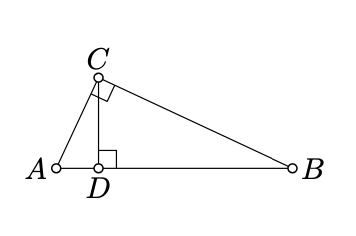6.2: Teorema de Pitágoras
- Page ID
- 114360
Un triángulo se llama a la derecha si uno de sus ángulos es recto. El lado opuesto al ángulo recto se llama hipotenusa. Los lados adyacentes al ángulo recto se llaman patas.
Supongamos que\(\triangle ABC\) es un triángulo rectángulo con el ángulo recto en\(C\). Entonces
\(AC^2 + BC^2 = AB^2.\)
- Prueba
-

Deja\(D\) ser el punto del pie de\(C\) on\((AB)\).
Según Lemma 5.5.1,
\(AD < AC < AB\)
y
\(BD < BC < AB.\)
Por lo tanto,\(D\) se encuentra entre\(A\) y\(B\); en particular,
\[AD + BD = AB.\]
Tenga en cuenta que por la condición de similitud AA, tenemos
\(\triangle ADC \sim \triangle ACB \sim \triangle CDB.\)
En particular,
\[\dfrac{AD}{AC} = \dfrac{AC}{AB} \text{ and } \dfrac{BD}{BC} = \dfrac{BC}{BA}.\]
Reescribamos las dos identidades en 6.2.2:
\(AC^2 = AB \cdot AD\)y\(BC^2 = AB \cdot BD\).
Resumiendo estas dos identidades y aplicando 6.2.1, obtenemos que
\(AC^2 + BC^2 = AB \cdot (AD + BD) = AB^2.\)
Asumir\(A, B, C\), y\(D\) son como en la prueba anterior. Demostrar que
\(CD^2 = AD \cdot BD.\)
El siguiente ejercicio es lo contrario al teorema de Pitágoras.
- Pista
-
Aplica eso\(\triangle ADC \sim \triangle CDB\).
Supongamos que\(ABC\) es un triángulo tal que
\(AC^2 + BC^2 = AB^2.\)
Demostrar que el ángulo a\(C\) es correcto.
- Pista
-
Aplicar el teorema de Pitágoras\(\PageIndex{1}\) y la condición de congruencia SSS


